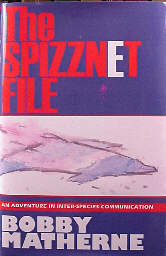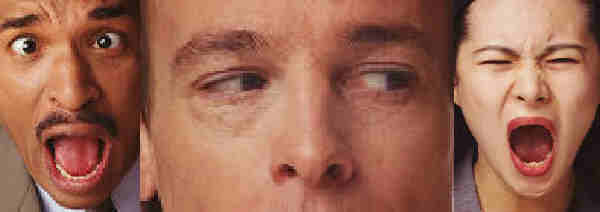![Dolphin -- Watercolor by Grandson Chris Bayhi [at 8 yrs old]](dolphin.gif)
Site Map: MAIN / SpizzNet Novel / This Page
![Dolphin -- Watercolor by Grandson Chris Bayhi [at 8 yrs old]](dolphin.gif)
Chapter 2: Doctor Doolittle
[Copyright 1997 by Bobby Matherne]
As the broadcast progressed, Dr. Mornay was perhaps the only person in the world whose eyes were not riveted to the screen. He had heard the stories before in his trial runs with the dolphins. He thought about how he hadn't always been interested in dolphins; originally it was dinosaurs.
As a kid in his small suburban town of Nine Mile, he discovered his dinosaurs at the local library at the age of five. Big color pictures of dinosaurs filled the books that he begged his mother to check out for him. By the age of five he had three younger brothers that kept his mother too busy to read to him, but he enjoyed looking at the pictures and learning to read the words on his own. The town's first library began in a vacant shoe shop along Sailboat Avenue, and he was soon to become its best customer.
He thought in his later years that it seemed the library had arrived there just in time to serve him. He would take home the maximum of five books every time he left the library, even if he already had five books at home. The librarian always gave him a questioning look, but never refused him a book.
Once she almost did, asking him questions about why he wanted this particular book. "It's just about the adventures of this little guy named Spiro," he said. The drawings of Spiro's journey from the surface of the skin, through the blood stream, into the eyeballs and all over the body fascinated him, and he read it repeatedly. Only years later did he discover that it was the story of the progress of a syphilis infection in the human body. At the age of fifty he met his librarian at a new library dedication. She still remembered him. "I always wondered if you really read all those books or just left them up on top of the icebox," she told him.
He read everything on the shelves of that little library. Although he liked old books the best, he always scouted the new book shelf for a Heinlein novel. He quickly read Space Cadet and Green Hills of Earth and whizzed through every other science fiction book on the shelves. He had spent years in space by the time he was ten, having explored the surface and subsurface of the Moon, Mars, and many other planetoids and asteroids. All from the floor of his bedroom. This was his favorite reading spot, mostly because he could read while he was supposed to be taking a nap there.
The library's largest collection of books by a single author was the Doctor Doolittle books. There must have been thirty or more novels full of Doctor Doolittle's adventures. Mornay never went to see the movie they finally made about the hero of his childhood. "Musical! Hah! Doctor Doolittle never sang! How childish! He was too busy talking to the animals for that sort of foolishness." Going from one book to the next till he had finished the shelf, he read every Doctor Doolittle book there.
He had dreams of talking to animals during this time. It seemed plausible to his eleven year old mind that one could talk to animals, if one spent the time to study how an animal made their sounds and to learn how to imitate their sounds. He took it for granted that speech, language, and two way communication with the animal would naturally result. What was the rooster's word for "hat"? Once you found that out, you could learn to make that sound and you could say "hat" to the rooster and it would "understand."
He would spend the rest of his adult life attempting to uncover the meaning of that word "understand." If how you know when a human being understands you is difficult enough to stump philosophers, how you know when another species understands you must be nearly impossible.
While he attending Nine Mile High School he read John Lilly's book Man and Dolphin and decided to study marine biology in college. Throughout his undergraduate studies he followed Lilly's work on dolphins. Assembling a bibliography of over sixty Lilly articles, he read all those of which he could locate a copy. The articles that attracted him the most concerned the cerebral cortex. Somehow the key to inter-species communication must be in this region of the brain, he thought. Unless an animal had a cerebral cortex as large as man's, there was little hope of communicating with it as an equal. In a senior psychology course he encountered the case of Kluge Hans, a trick horse, and that story convinced him that Lilly was on the right track with Tersiops Truncatus or the bottlenose dolphin. Animals such as horses, without a brain-to-body weight ratio comparable to man, could be excluded from consideration for inter-species communication.
The story of Kluge Hans (Clever John) taught him the difficulty and the pitfalls of inter-species communication. A horse trainer had discovered a horse that could answer questions by tapping out the answers with his hoof. Hans could not only add and multiply numbers with ease, but he could also tell people about their personal lives, such as how many children they had. Answers such as these seemed to place the horse in the category of mind reader and a scientific team arrived to investigate.
The first thing they did was to remove the trainer from the room. This did not reduce Hans's ability to answer questions with accuracy, but it did convince the team that it was not signals from the trainer that cued Hans as to the answer. They became increasingly perplexed. It began to appear to them that they had discovered the first example of inter-species communication, and it was definitely two-way communication. They had become convinced that, given vocal cords, Hans would be quite a conversationalist, a veritable Francis the Talking Mule or a Mr. Ed the Talking Horse.
One scientist had an idea. He removed from the examination room all of the people who knew the answer to the next set of questions, and Hans was not able to answer a single question correctly. Unbeknownst to the trainer and scientists, Hans had been picking up subliminal cues to stop tapping from whichever person knew the answer to a question. He had learned to generalize from his trainer's signals to other people's signals, signals they themselves were not aware of giving. Hans was a smart horse all right, but no paragon of inter-species communication, no Francis or Mr. Ed, just a clever circus act. Talking with the animals like Doctor Doolittle would remain a dream for now because that essence of communication - understanding - was missing.
Through extensive reading of Lilly's work he became interested in the possibility of communication with the bottlenose dolphins, Tersiops Truncatus. This species' ratio of brain weight to body length from newborn to adult exactly tracks that of humans. Lilly's writings convinced him that there was a critical brain size for language to be possible. Mornay's decision to concentrate on dolphins for his post graduate studies was easy.
As soon as he graduated from the University of Miami, he had his first child by Edith and entered graduate school. He joined Lilly's research team and began working on dolphin communication as part of his doctoral work in Marine Biology. He titled his dissertation "Inter-species Communication Between Homo Sapiens and Tersiops Truncatus." His dissertation was accepted even though his research efforts had reached a negative conclusion: It was not possible to teach dolphins to talk like humans. Lilly's dolphin experiments were off-track, he claimed, because they were trying to teach dolphins to communicate like humans did, via verbalizations. Something was missing, some key element, and he promised himself he'd find it.
He remembered that Dr. Doolittle learned to talk like the animals and he kept looking for a way that humans could learn to talk like dolphins. After receiving his Ph.D. in marine biology, he gave up his dolphin studies and worked on a pattern recognition project at Tulane University. A researcher there was attempting to create a computerized neural network and train it to recognize pathology in radiographs (chest x-rays). By scanning numerous chest x-rays and feeding them into a neural network designed using Rosenblatt's unique Perceptron Model, he hoped to teach them to distinguish normal x-rays from those with various lesions or pathology. The project was very ambitious in that it pushed the state of the art in scanner technology, neural network design, and computer capability.
The image processing project spun off into several sub-projects: automated calculation of cardio-thoracic ratios, karotyping of chromosomes, detection of enlarged thyroid glands, calculation of atherosclerotic deposits on arteries. He worked on each of these and for several years his only thought of dolphins came in his dreams.
The dolphin dreams had begun while he was doing field work on his dissertation at Lilly's dolphin research center in Miami and the Virgin Islands. Each dream was similar. A dolphin with a notch on the front of its dorsal fin would appear and suddenly Mornay would find himself speeding through the ocean, past schools of fish, exploring reefs, or jumping in flying leaps out of the water. Each time this one dolphin appeared, Mornay would turn into a dolphin for the rest of the dream and looked forward to the next appearance of his dolphin friend. He began a pattern of studying computer software, neural networks, and image processing during day and doing his marine biology at night in his dreams.
Meanwhile his personal life began a roller coaster ride. His marriage to Edie had produced two wonderful children, but his relationship with Edie had not matured over the years. He loved her and the two girls and made a good home for them, but he began to feel that something essential was missing in his marriage and his life.
~~~
Suddenly his attention returned to the screen -- the dolphins were about to tell the Nimrod story.
Eons passed after Lomba had led us Dolphin People into the sea before our next great leader, Nimrod, appeared. Our metamorphosis into sea creatures was complete by then - our hands and feet had been transformed into flippers and tail fin. Our bodies had become encased in blubber for warmth, and we could see with our ears and speak pictures to communicate with others of our kind.
It was at the time the Human People know as the Great Flood that Nimrod lived. Nimrod was the first of us Dolphin People to be known as the Great Dolphin. No one since Lomba himself had so perfected the healing process as Nimrod. He called his process "overlighting" and described it as the technique of speaking a healthy image of the sick dolphin and aligning the image perfectly over the diseased body. "During overlighting," he taught, "the sick body resonates at a cellular level with the healthy image and as it vibrates, the body begins its journey back into a healthy condition." Besides being a healer, Nimrod was also a teacher, for whenever he healed someone, he told them, "Go you, too, and do likewise."
Nimrod was also the first sculptor among us Dolphin People. He invented the process of sculpting living organisms with his voice. Using his overlighting process on various species of brain coral, he managed to create three-dimensional images in the coral. His favorite sculpture subjects were the heads of Human People, and he sculpted many of them in brain coral. Nimrod taught us Dolphin People how he did his sculpting: he would speak the image of an object and align it on a similar piece of brain coral. The tiny coral animals would atrophy and die where there was no vibration and grow vigorously where there was vibration. Over the course of days after he had overlighted the image on the coral, the sculpture took its initial shape, and grew into its final shape over months. Some Nimrod sculptures of human heads are still visible in the oceans, some thousands of years after he lived, due to the subsequent petrification of the original coral animals.
The greatest invention of Nimrod was dolphin writing. Without this invention, we Dolphin People would still be creatures without a recorded history. These very stories we are sharing with you have been made possible by the books that the Great Nimrod wrote in the creatures of the sea. He discovered that some living animals did not change their shape like the brain coral did when he stored an image in them. This disappointed him at first, but he later discovered that the images he had stored in them could be retrieved later by himself and others. Not only that, but many images could be stored and retrieved in one sea creature, the sand dollar. This small, disk-shaped creature became his writing tablets. He taught us Dolphin People to read his tablets and how to write for ourselves. We know these things happened because Nimrod and his pupils transcribed these events into sand dollars. The earlier stories of Lomba and the entry into the sea had been carried down through the oral tradition until Nimrod transcribed them onto the sand dollars. He is known as the Father of Writing to us Dolphin People.
[End of Dr. Doolittle/Chapter 2. To Read Next Chapter Click Book Jacket at Right:]


Are you unhappy with your life? Fearful? Angry? Anxious? Feel down or upset by everyday occurrences? Plagued by chronic discomforts like migraines or tension-type headaches? At Last! An Alternative Approach to Removing Unwanted Physical Body States without Drugs or Psychotherapy!Click on Faces Below.

